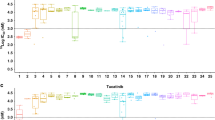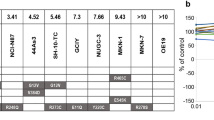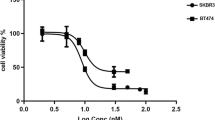Abstract
The PI3K pathway is a key mechanism of trastuzumab resistance, but early attempts to indirectly target this pathway with mTOR inhibitors have had limited success. We present the results of a preclinical study of the selective alpha/delta isoform dominant PI3K inhibitor BAY 80-6946 tested alone and in combination with HER2-targeted therapies in HER2-positive cell lines, including models with acquired resistance to trastuzumab and/or lapatinib. A panel of HER2-positive breast cancer cells were profiled for their mutational status using Sequenom MassARRAY, PTEN status by Western blot, and anti-proliferative response to BAY 80-6946 alone and in combination with the HER2-targeted therapies trastuzumab, lapatinib and afatinib. Reverse phase protein array was used to determine the effect of BAY 80-6946 on expression and phosphorylation of 68 proteins including members of the PI3K and MAPK pathways. The Boyden chamber method was used to determine if BAY 80-6946 affected cellular invasion and migration. BAY 80-6946 has anti-proliferative and anti-invasive effects when used alone in our panel of cell lines (IC50s 3.9–29.4 nM). BAY 80-6946 inhibited PI3K signalling and was effective in cells regardless of their PI3K, P53 or PTEN status. The combination of HER2-targeted therapies and BAY 80-6946 inhibited growth more effectively than either therapy used alone (with clear synergism in many cases), and can restore sensitivity to trastuzumab and lapatinib in cells with acquired resistance to either trastuzumab and/or lapatinib. The addition of BAY 80-6946 to HER2-targeted therapy could represent an improved treatment strategy for patients with refractory metastatic HER2-positive breast cancer, and should be considered for clinical trial evaluation.



Similar content being viewed by others

References
Slamon DJ, Clark GM, Wong SG, Levin WJ, Ullrich A, McGuire WL (1987) Human breast cancer: correlation of relapse and survival with amplification of the HER-2/neu oncogene. Science 235(4785):177–182
Piccart-Gebhart MJ, Procter M, Leyland-Jones B, Goldhirsch A, Untch M, Smith I, Gianni L, Baselga J, Bell R, Jackisch C, Cameron D, Dowsett M, Barrios CH, Steger G, Huang CS, Andersson M, Inbar M, Lichinitser M, Lang I, Nitz U, Iwata H, Thomssen C, Lohrisch C, Suter TM, Ruschoff J, Suto T, Greatorex V, Ward C, Straehle C, McFadden E, Dolci MS, Gelber RD, Herceptin Adjuvant Trial Study T (2005) Trastuzumab after adjuvant chemotherapy in HER2-positive breast cancer. N Engl J Med 353(16):1659–1672. doi:10.1056/NEJMoa052306
Scaltriti M, Chandarlapaty S, Prudkin L, Aura C, Jimenez J, Angelini PD, Sanchez G, Guzman M, Parra JL, Ellis C, Gagnon R, Koehler M, Gomez H, Geyer C, Cameron D, Arribas J, Rosen N, Baselga J (2010) Clinical benefit of lapatinib-based therapy in patients with human epidermal growth factor receptor 2-positive breast tumors coexpressing the truncated p95HER2 receptor. Clin Cancer Res 16(9):2688–2695. doi:10.1158/1078-0432.CCR-09-3407
Hennessy BT, Smith DL, Ram PT, Lu Y, Mills GB (2005) Exploiting the PI3K/AKT pathway for cancer drug discovery. Nat Rev Drug Discov 4(12):988–1004. doi:10.1038/nrd1902
Stemke-Hale K, Gonzalez-Angulo AM, Lluch A, Neve RM, Kuo WL, Davies M, Carey M, Hu Z, Guan Y, Sahin A, Symmans WF, Pusztai L, Nolden LK, Horlings H, Berns K, Hung MC, van de Vijver MJ, Valero V, Gray JW, Bernards R, Mills GB, Hennessy BT (2008) An integrative genomic and proteomic analysis of PIK3CA, PTEN, and AKT mutations in breast cancer. Cancer Res 68(15):6084–6091. doi:10.1158/0008-5472.CAN-07-6854
Berns K, Horlings HM, Hennessy BT, Madiredjo M, Hijmans EM, Beelen K, Linn SC, Gonzalez-Angulo AM, Stemke-Hale K, Hauptmann M, Beijersbergen RL, Mills GB, van de Vijver MJ, Bernards R (2007) A functional genetic approach identifies the PI3K pathway as a major determinant of trastuzumab resistance in breast cancer. Cancer Cell 12(4):395–402. doi:10.1016/j.ccr.2007.08.030
Gallardo A, Lerma E, Escuin D, Tibau A, Munoz J, Ojeda B, Barnadas A, Adrover E, Sanchez-Tejada L, Giner D, Ortiz-Martinez F, Peiro G (2012) Increased signalling of EGFR and IGF1R, and deregulation of PTEN/PI3K/Akt pathway are related with trastuzumab resistance in HER2 breast carcinomas. Br J Cancer 106(8):1367–1373. doi:10.1038/bjc.2012.85
Gayle SS, Arnold SL, O’Regan RM, Nahta R (2012) Pharmacologic inhibition of mTOR improves lapatinib sensitivity in HER2-overexpressing breast cancer cells with primary trastuzumab resistance. Anticancer Agents Med Chem 12(2):151–162
Chan S, Scheulen ME, Johnston S, Mross K, Cardoso F, Dittrich C, Eiermann W, Hess D, Morant R, Semiglazov V, Borner M, Salzberg M, Ostapenko V, Illiger HJ, Behringer D, Bardy-Bouxin N, Boni J, Kong S, Cincotta M, Moore L (2005) Phase II study of temsirolimus (CCI-779), a novel inhibitor of mTOR, in heavily pretreated patients with locally advanced or metastatic breast cancer. J Clin Oncol 23(23):5314–5322. doi:10.1200/JCO.2005.66.130
Sun SY, Rosenberg LM, Wang X, Zhou Z, Yue P, Fu H, Khuri FR (2005) Activation of Akt and eIF4E survival pathways by rapamycin-mediated mammalian target of rapamycin inhibition. Cancer Res 65(16):7052–7058. doi:10.1158/0008-5472.CAN-05-0917
Liu NRB, Schneider C, Bull C, Hoffmann J, Kaekoenen S, Hentemann M, Scott W, Mumberg D, Ziegelbauer K (2010) BAY 80-6946, a highly selective and potent pan-class I PI3K inhibitor, induces tumor apoptosis in vitro and tumor regression in vivo in a subset of tumor models. Paper presented at the American Association for Cancer Research, Washington DC
Liu NHA, Bull C, Schatz C, Wiehr S, Pichler BJ, Hauff P, Mumberg D, Jenkins S, Schwarz T, Ziegelbauer K (2010) BAY 80-6946, a highly potent and efficacious PI3K class I inhibitor, induces complete tumor regression or tumor stasis in tumor xenograft models with PIK3CA mutant or PTEN deletion. Paper presented at the American Association for Cancer Research, Washington DC
Liu N, Rowley BR, Bull CO, Schneider C, Haegebarth A, Schatz CA, Fracasso PR, Wilkie DP, Hentemann M, Wilhelm SM, Scott WJ, Mumberg D, Ziegelbauer K (2013) BAY 80-6946 is a highly selective intravenous PI3K inhibitor with potent p110alpha and p110delta activities in tumor cell lines and xenograft models. Mol Cancer Ther 12(11):2319–2330. doi:10.1158/1535-7163.MCT-12-0993-T
Glauer J, Pletz N, Schon M, Schneider P, Liu N, Ziegelbauer K, Emmert S, Wulf GG, Schon MP (2013) A novel selective small-molecule PI3K inhibitor is effective against human multiple myeloma in vitro and in vivo. Blood Cancer J 3:e141. doi:10.1038/bcj.2013.37
Lotze MTAL, Ramanathan RK, Tolcher AW, Beeram M, Papadopoulos KP, Rasco DW, Weiss GJ, Mountz JM, Toledo FGS, Alvarez RJ, Oborski MJ, Rajagopalan P, Jeffers M, Roth D, Duboxy RL, Patnaik A (2012) Phase I study of intravenous PI3K inhibitor BAY 80-6946: activity in patients with advanced solid tumors and non-Hodgkin’s lymphoma treated in MTD expansion cohorts. Paper presented at the American Society of Clinical Oncology, Chicago, Illinois
Eustace AJ, Crown J, Clynes M, O’Donovan N (2008) Preclinical evaluation of dasatinib, a potent Src kinase inhibitor, in melanoma cell lines. J Transl Med 6:53. doi:10.1186/1479-5876-6-53
Hennessy BT, Lu Y, Gonzalez-Angulo AM, Carey MS, Myhre S, Ju Z, Davies MA, Liu W, Coombes K, Meric-Bernstam F, Bedrosian I, McGahren M, Agarwal R, Zhang F, Overgaard J, Alsner J, Neve RM, Kuo WL, Gray JW, Borresen-Dale AL, Mills GB (2010) A technical assessment of the utility of reverse phase protein arrays for the study of the functional proteome in non-microdissected human breast cancers. Clin Proteomics 6(4):129–151. doi:10.1007/s12014-010-9055-y
Saal LH, Holm K, Maurer M, Memeo L, Su T, Wang X, Yu JS, Malmstrom PO, Mansukhani M, Enoksson J, Hibshoosh H, Borg A, Parsons R (2005) PIK3CA mutations correlate with hormone receptors, node metastasis, and ERBB2, and are mutually exclusive with PTEN loss in human breast carcinoma. Cancer Res 65(7):2554–2559. doi:10.1158/0008-5472-CAN-04-3913
O’Brien NA, Browne BC, Chow L, Wang Y, Ginther C, Arboleda J, Duffy MJ, Crown J, O’Donovan N, Slamon DJ (2010) Activated phosphoinositide 3-kinase/AKT signaling confers resistance to trastuzumab but not lapatinib. Mol Cancer Ther 9(6):1489–1502. doi:10.1158/1535-7163.MCT-09-1171
O’Regan R, Ozguroglu M, Andre F, Toi M, Jerusalem G, Wilks S, Isaacs C, Xu B, Masuda N, Arena F, Yardley D, Yap Y, Mukhopadhyay P, Douma S, El-Hashimy M, Taran T, Sahmoud T, Lebwohl D, Gianni L (2013) Phase III, randomized, double-blind, placebo-controlled multicenter trial of daily everolimus plus weekly trastuzumab and vinorelbine in trastuzumab-resistant, advanced breast cancer (BOLERO-3). J Clin Oncol 31(suppl; abstr 505)
Chen JSWQ, Fu XH, Huang XH, Chen X, Cao L, Chen L, Tan H, Li W, Bi J, Zhang L (2008) Involvement of PI3K/PTEN/AKT/mTOR pathway in invasion and metastasis in hepatocellular carcinoma: association with MMP-9. Hepatol Res 39(2):177–186
Asrani K, Keri RA, Galisteo R, Brown SA, Morgan SJ, Ghosh A, Tran NL, Winkles JA (2013) The HER2- and heregulin beta1 (HRG)-inducible TNFR superfamily member Fn14 promotes HRG-driven breast cancer cell migration, invasion, and MMP9 expression. Mol Cancer Res 11(4):393–404. doi:10.1158/1541-7786.MCR-12-0542
Seyfried TN, Huysentruyt LC (2013) On the origin of cancer metastasis. Crit Rev Oncog 18(1–2):43–73
Hennessy BT, Lu Y, Poradosu E, Yu Q, Yu S, Hall H, Carey MS, Ravoori M, Gonzalez-Angulo AM, Birch R, Henderson IC, Kundra V, Mills GB (2007) Pharmacodynamic markers of perifosine efficacy. Clin Cancer Res 13(24):7421–7431. doi:10.1158/1078-0432.CCR-07-0760
Vasudevan KM, Barbie DA, Davies MA, Rabinovsky R, McNear CJ, Kim JJ, Hennessy BT, Tseng H, Pochanard P, Kim SY, Dunn IF, Schinzel AC, Sandy P, Hoersch S, Sheng Q, Gupta PB, Boehm JS, Reiling JH, Silver S, Lu Y, Stemke-Hale K, Dutta B, Joy C, Sahin AA, Gonzalez-Angulo AM, Lluch A, Rameh LE, Jacks T, Root DE, Lander ES, Mills GB, Hahn WC, Sellers WR, Garraway LA (2009) AKT-independent signaling downstream of oncogenic PIK3CA mutations in human cancer. Cancer Cell 16(1):21–32. doi:10.1016/j.ccr.2009.04.012
Garrett JT, Olivares MG, Rinehart C, Granja-Ingram ND, Sanchez V, Chakrabarty A, Dave B, Cook RS, Pao W, McKinely E, Manning HC, Chang J, Arteaga CL (2011) Transcriptional and posttranslational up-regulation of HER3 (ErbB3) compensates for inhibition of the HER2 tyrosine kinase. Proc Natl Acad Sci USA 108(12):5021–5026. doi:10.1073/pnas.1016140108
Chakrabarty A, Sanchez V, Kuba MG, Rinehart C, Arteaga CL (2012) Feedback upregulation of HER3 (ErbB3) expression and activity attenuates antitumor effect of PI3K inhibitors. Proc Natl Acad Sci USA 109(8):2718–2723. doi:10.1073/pnas.1018001108
Serra V, Scaltriti M, Prudkin L, Eichhorn PJ, Ibrahim YH, Chandarlapaty S, Markman B, Rodriguez O, Guzman M, Rodriguez S, Gili M, Russillo M, Parra JL, Singh S, Arribas J, Rosen N, Baselga J (2011) PI3K inhibition results in enhanced HER signaling and acquired ERK dependency in HER2-overexpressing breast cancer. Oncogene 30(22):2547–2557. doi:10.1038/onc.2010.626
Acknowledgments
We thank Dr. Scott Wilhelm and Bayer Pharmaceuticals for providing us with BAY 80-6946. We also thank Dr. Norma O’Donovan, Dublin City University, for her gift of SKBR3-T, SKBR3-L, SKBR3-TL and HCC1954-L, and Dr. Neil O’Brien, University of California Los Angeles, for BT474-PAR and BT474-Res. We also thank St James University Hospital pharmacy for providing us with trastuzumab.
Conflict of interest
The authors state that they have no conflicts of interest in relation to this article or the funding bodies.
Financial information
This work was supported by Irish Cancer Society Research (CRS11ELS), Health Research Board (HRA/POR2012/054), BREAST-PREDICT, NECRET, the North Eastern Cancer Research and Education Trust and the Royal Irish Academy Mobility Grant 2013.
Author information
Authors and Affiliations
Corresponding author
Additional information
B. T. Hennessy and A. J. Eustace, joint senior authors have contributed equally to this work.
Electronic supplementary material
Below is the link to the electronic supplementary material.
10549_2014_3239_MOESM1_ESM.docx
Supplementary Fig. 1: Effect of 5nM BAY 80-6946 on (a) invasion and (b) migration in MDAMB453 and BT474 cells over a 24 h period. Error bars represent standard deviations of triplicate experiments. ‘*’ represents p < 0.05 as calculated by Student’s t-test. Supplementary material 1 (DOCX 56 kb)
10549_2014_3239_MOESM2_ESM.docx
Supplementary Fig. 2: Percentage changes in protein expression or phosphorylation as calculated from RPPA analysis following treatment of cells with 1nM BAY 80-6946 for 6 h relative to untreated controls in A) panel of HER2 positive BC cells, B) SKBR3 parental and resistant models C) HCC1954 and BT474 parental and resistant models. Standard deviations are calculated using propagation of error from triplicate independent biological experiments. Supplementary material 2 (DOCX 126 kb)
10549_2014_3239_MOESM3_ESM.docx
Supplementary Fig. 3: Percentage changes in protein expression or phosphorylation as calculated from RPPA analysis following treatment of cells with ‘●‘1nM BAY 80-6946, ‘▲‘lapatinib or ‘□‘a combination of lapatinib and BAY 80-6946 for 30 min relative to untreated controls SKBR3 and HCC1954 parental and lapatinib resistant cells. Standard deviations are calculated using propagation of error from triplicate independent biological experiments. Supplementary material 3 (DOCX 110 kb)
10549_2014_3239_MOESM4_ESM.docx
Supplementary Fig. 4: Efficacy of lapatinib or afatinib (-◊-), BAY 80-6946 (-□-) and a combination of lapatinib or afatinib with BAY 80-6946 (–∆–) in MDAMB453 cell lines which have de novo resistance to HER2-inhibitors. Error bars are representative of standard deviations across triplicate experiments. The ratio of lapatinib: BAY 80-6946 in this assay is fixed at 1:1. Supplementary material 4 (DOCX 50 kb)
Rights and permissions
About this article
Cite this article
Elster, N., Cremona, M., Morgan, C. et al. A preclinical evaluation of the PI3K alpha/delta dominant inhibitor BAY 80-6946 in HER2-positive breast cancer models with acquired resistance to the HER2-targeted therapies trastuzumab and lapatinib. Breast Cancer Res Treat 149, 373–383 (2015). https://doi.org/10.1007/s10549-014-3239-5
Received:
Accepted:
Published:
Issue Date:
DOI: https://doi.org/10.1007/s10549-014-3239-5



